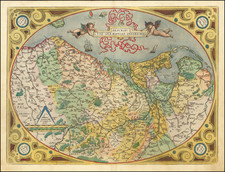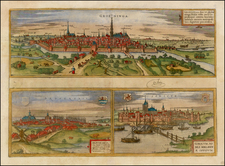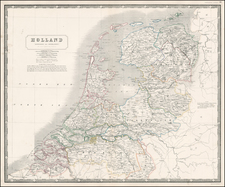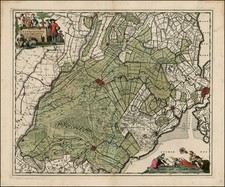A detailed town plan of Rotterdam, showing the town, harbor, fortified walls, canals, waterfront, important public buildings, squares, and more. Large ships are shown in the river in the foreground, with many smaller trading vessels scattered throughout the city. A key names twenty places and the coat of arms in the city is shown in the upper right.
This map shows Rotterdam as a small port city of approximately 20,000. Now a metropolis of over half a million, Rotterdam is one of the banking and shipping centers of Europe with the headquarters of many multinationals including Deloitte, Unilever, Pfizer and Vitol. Here, the city is limited to what is presently known as the Maritime District. The River Rotte flows into the Maas, effectively using the city as a delta.
The key lists many of the points of interest of seventeenth-century Rotterdam. Unfortunately, the St. Lawrence church (key number 2) is one of the few monuments which remain from old Rotterdam. Much of the city was leveled in 1940 as retribution for unexpectedly fierce resistance to invading German forces, and the severity of this bombing led to the immediate Dutch surrender. The city was rebuilt after the war in an attractive and very modern style, but the traditional layout, as preserved in this map, has been lost.
This is a fine, full-colored example of Merian's Rotterdam.
Mathaus Merian (1593-1650) was the father of engraver Matthäus the Younger, and of the painter, engraver, and naturalist Maria Sibylla Merian. He was born in Basel, Switzerland and trained in engraving in Zurich. After a time in Nancy, Paris and Strasbourg, he settled in Frankfurt. While there, he worked for Johann Theodor de Bry, the publisher and son of the travel writer. In 1617, he married Maria Magdalena de Bry, Johann Theodor’s daughter. In 1623, Merian took over the de Bry publishing house upon the death of his father-in-law. Merian’s best known works are detailed town views which, due to their accuracy and artistry, form a valuable record of European urban life in the first half of the sixteenth century












![(The Wardington Copy) De Vyerighe Colom Klaer Vertoonende in vyftich onderscheydene Curieuse Caarten De XVII Nederlantsche Provincien, Alsmede De Hartogen. . . [The Flaming Column, Clearly Showing in Fifty Different Curious Maps the Seventeen Dutch Provinces, as well as the Dukes...]](https://storage.googleapis.com/raremaps/img/small/89628.jpg)

